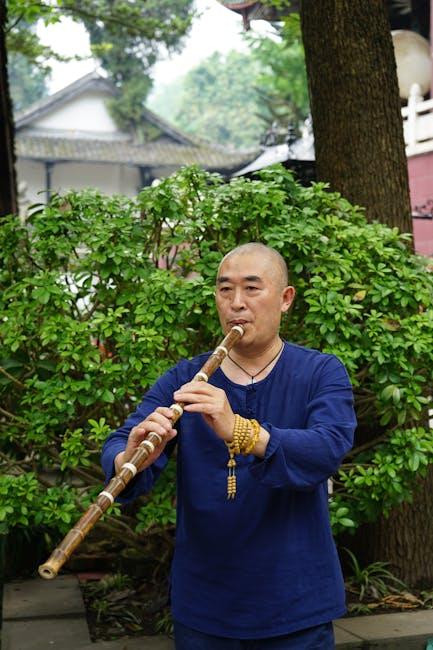In the quiet whispers of ancient China, where the rivers carved their paths through mist-shrouded mountains and bamboo groves swayed to the rhythm of the wind, a profound journey inward was taking shape. Meditation, a practice woven into the very fabric of Chinese philosophy and daily life, served as a bridge between the corporeal and the ethereal, the known and the mysterious. This ancient art, deeply rooted in the teachings of Taoism, Confucianism, and Buddhism, beckoned seekers to explore the vast landscapes of the mind and spirit. In this article, we delve into the rich tapestry of meditation in ancient China, unraveling its philosophical underpinnings and examining the practices that have transcended centuries, offering insights into the harmonious balance between body, mind, and the universe. Join us as we embark on a tranquil exploration of a tradition that continues to resonate in the modern world, a testament to its timeless relevance and transformative power.
Roots of Serenity the Philosophical Foundations of Meditation in Ancient China
In ancient China, meditation was deeply intertwined with the philosophical underpinnings of Taoism and Confucianism. These philosophies provided a rich tapestry of ideas that influenced the development of meditative practices. Taoism, with its emphasis on harmony with the Tao or ”The Way,” encouraged individuals to find balance and peace within themselves and the universe. This philosophy promoted meditation as a means to transcend the mundane and connect with the cosmic flow of life. Confucianism, on the other hand, focused on the cultivation of moral virtues and the betterment of the self through reflection and mindfulness. Meditation, in this context, was seen as a tool to achieve inner peace and ethical clarity, allowing individuals to act with integrity and wisdom in their daily lives.
- Taoist Meditation: Aimed at aligning with the natural order and achieving spiritual enlightenment.
- Confucian Meditation: Focused on self-cultivation and the development of personal virtues.
- Influence of Nature: Nature was often used as a metaphor for the meditative journey, symbolizing growth, tranquility, and interconnectedness.
These philosophical foundations laid the groundwork for meditation practices that not only sought personal tranquility but also aspired to harmonize the individual with society and the cosmos. Through the lens of these ancient philosophies, meditation was not merely a personal endeavor but a path towards a greater understanding of one’s place in the world.

Breathing with the Cosmos Techniques and Rituals of Ancient Chinese Meditation
In the heart of ancient Chinese meditation, practitioners discovered a profound connection between the breath and the cosmos. This spiritual journey was guided by a series of techniques and rituals that transcended mere relaxation, aiming instead for a harmonious alignment with the universe. Qi Gong, a cornerstone of these practices, emphasized controlled breathing and movement to cultivate life force energy, known as Qi. This practice not only enhanced physical health but also deepened spiritual awareness.
- Cosmic Breathing: A meditative technique that involves visualizing the breath as a bridge between the individual and the universe, promoting a sense of unity and tranquility.
- Celestial Alignment Rituals: These involve specific postures and gestures aimed at channeling cosmic energies, believed to align one’s personal Qi with the greater cosmic flow.
- Nature Integration: Practitioners often meditated in natural settings, using the elements as guides to deepen their connection with the earth and sky.
These ancient practices, steeped in philosophical traditions, continue to inspire modern meditation enthusiasts, offering timeless wisdom on the art of inner peace and cosmic harmony.

Wisdom of the Sages How Ancient Practices Inspire Modern Mindfulness
In the serene landscapes of ancient China, meditation was not merely a practice but a profound journey towards understanding the cosmos and the self. The sages of yore perceived meditation as a gateway to achieving harmony with the universe, emphasizing a balance between the internal spirit and the external world. Rooted deeply in Taoist and Confucian philosophies, meditation practices were designed to cultivate inner peace, enhance self-awareness, and foster a connection with nature’s rhythms. These teachings have gracefully transcended time, offering valuable insights into modern mindfulness practices.
- Qi Gong: This ancient practice combines meditation, controlled breathing, and movement to cultivate and balance qi (life energy). Today, it inspires mindful breathing techniques and body awareness exercises.
- Zhuangzi’s Teachings: Emphasizing the relativity of things, Zhuangzi encouraged a state of effortless action, or “Wu Wei,” which aligns closely with today’s concept of living mindfully without force.
- Confucian Reflection: Confucius advocated for self-reflection as a means of moral development, a precursor to the introspective practices found in modern mindfulness.
These ancient practices underscore the timeless quest for tranquility and understanding, providing a rich tapestry of wisdom that continues to influence contemporary mindfulness movements. By integrating these ancient philosophies into daily life, one can embark on a journey of personal growth and serenity.

Cultivating Inner Peace Practical Recommendations from Ancient Chinese Traditions
The wisdom of ancient Chinese traditions offers a profound approach to cultivating inner peace through practices deeply rooted in harmony and balance. Central to these traditions is the art of meditation, which is more than a mere relaxation technique; it is a gateway to understanding the self and the universe. By embracing the principles of Taoism and Confucianism, practitioners can find a pathway to serenity that aligns the mind, body, and spirit.
To integrate these ancient philosophies into modern life, consider the following practical recommendations:
- Embrace Simplicity: Simplifying your surroundings and lifestyle can help to reduce distractions and foster a peaceful environment.
- Practice Mindful Breathing: Focus on your breath as a tool to anchor your mind in the present moment, promoting calm and clarity.
- Engage in Tai Chi: This gentle martial art combines movement and meditation, enhancing physical health and mental tranquility.
- Reflect on Nature: Spend time in nature to connect with the world around you, which is a central tenet of ancient Chinese practices.
Wrapping Up
As the sun sets on our exploration of meditation in ancient China, we find ourselves standing at the crossroads of philosophy and practice, where the whispers of the past continue to resonate in the present. Through the mist of time, we have journeyed alongside sages and scholars, unraveling the threads of a tradition that weaves together mind, body, and spirit. This rich tapestry of meditation, steeped in the wisdom of Confucian, Daoist, and Buddhist thought, invites us to pause and reflect on our own paths.
In this ancient land, meditation was more than a mere practice; it was a way of life, a compass guiding seekers towards harmony and enlightenment. It called for a delicate balance, a dance between the inner and outer worlds, fostering a profound understanding of oneself and the universe. As we close this chapter, we are reminded that these teachings, though rooted in the past, continue to offer timeless insights for modern seekers.
Let us carry forward the essence of this ancient wisdom, allowing it to illuminate our daily lives. Whether we seek solace, clarity, or a deeper connection to the world around us, the meditative practices of ancient China beckon us to listen, breathe, and simply be. And so, as we part ways, may we each find our own tranquil center amidst the swirling currents of existence, ever mindful of the journey within.
